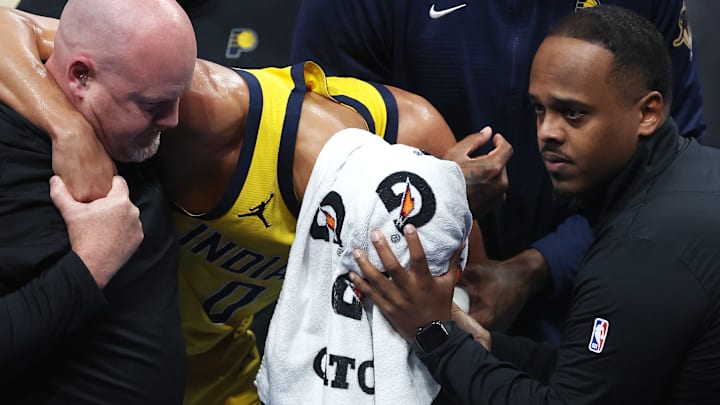When the Indiana Pacers reacquired the rights to their 2026 NBA draft pick from the New Orleans Pelicans, they did so with the intention of making Myles Turner's return next season more financially palatable. Now, on the heels of Tyrese Haliburton suffering a torn right Achilles tendon, this minor bookkeeping move has the potential to help the franchise preserve its future.
To be clear: There is no silver lining to Haliburton's injury, which has officially been confirmed as a torn right Achilles tendon, according to ESPN's Shams Charania. So much of the Pacers' future is now thrust into doubt.
Haliburton will almost certainly miss the entire 2025-26 season, likely forcing Indiana into a gap year. But this isn't an injury with effects that will linger through one 82-game schedule. The Pacers have no idea what Haliburton will look like upon return, be it at the end of next season or to start the 2026-27 campaign.
Players have started coming back stronger than they did before from these types of injuries. Kevin Durant is the most prominent example, and Haliburton, at 25 years old, is significantly younger. But this is still a major setback.
At the very least, it will take Haliburton some time to regain his footing when he does return. And it could turn out this is an injury that must be managed for the rest of his career. Does he play most back-to-backs? Will his minutes need to be rigidly monitored? It’s all on the table.
That is objectively a bummer, and it complicates Indiana’s team-building process in the years to come. Having next season’s draft pick back in the fold will not solve everything, but it opens up more possibilities the team can explore.
The Pacer can now make the most out of a potential gap year
Even if the Pacers don’t pivot into tank mode next year, they are going to be significantly worse without their best player. What initially looked like a shoo-in for a top-three 2026 playoff seed could not feasibly be a lottery squad.
This type of finish will be tough to stomach immediately after making an NBA Finals. It would have been impossible to process if the Pelicans were drafting in the Pacers’ place. They won’t be anymore.
Indiana’s 2026 NBA draft pick is all its own. So while this isn’t a team known for steering into egregious tanks, it can prioritize top-tier lottery odds if it chooses. And from there, the Pacers could enter the 2026-27 season largely with the same core that brought them to the Finals, plus the addition of a top-tier prospect on a cost-controlled rookie-scale contract.
Do not underestimate the importance of that last point. The Pacers only traded the No. 23 pick in this year’s draft for their 2026 first-rounder because it saved them $3.2 million in salary for next season. That may not seem like much, but when you’re preparing to pay the luxury tax for the first time since 2005, every little bit counts.
Indiana's 2026 first-round pick could wear many hats
It is impossible to assess the value of the Pacers’ 2026 draft pick right now. A lot hinges not only on their goals, but how Haliburton’s injury impacts their offseason.
Indiana was on track to pay the tax to retain Turner. Could it now let him walk? Or will it be inclined to offload other salaries and skirt the tax knowing Haliburton won’t play next year?
On a heavier note, do the Pacers think Pascal Siakam will still be second-option material? He will be entering his age-32 season when Haliburton returns, and could be 33 or older before Indiana is ready to resume its contention window.
These questions can’t be answered now—or even over one summer. But the Pacers have the opportunity to add a valuable and cheap depth piece, potential cornerstone, or primo trade asset with their 2026 first-rounder.
None of this truly softens the blow of Haliburton’s injury. Still, what was once a minor trade is now a move that could prove pivotal to Indiana’s competitive livelihood in the years to come.
